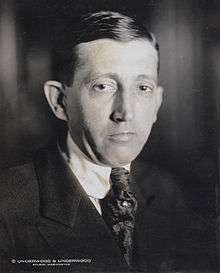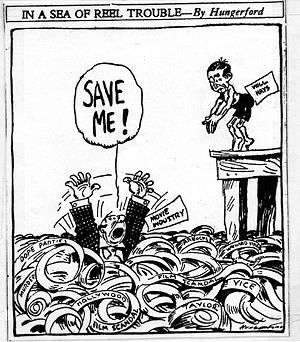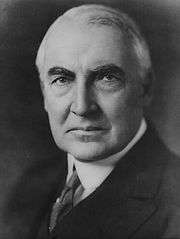Will H. Hays
| Will H. Hays | |
|---|---|
 | |
| 46th United States Postmaster General | |
|
In office March 5, 1921 – March 3, 1922 | |
| President | Warren G. Harding |
| Preceded by | Albert S. Burleson |
| Succeeded by | Hubert Work |
| Personal details | |
| Born |
William Harrison Hays November 5, 1879 Sullivan, Indiana, United States |
| Died |
March 7, 1954 (aged 74) Sullivan, Indiana, United States |
| Political party | Republican |
| Spouse(s) | Jessie Herron Hays (1879-1960) |
| Profession | Politician, President of the MPAA |
| Known for | Hayes Code |
| Religion | Presbyterian |
William Harrison Hays, Sr. (/heɪz/; November 5, 1879 – March 7, 1954), namesake of the Hays Code for censorship of American films, was chairman of the Republican National Committee (1918–21) and U.S. Postmaster General (1921–22).[1]
Biography
Hays was born in Sullivan, Indiana, on November 5, 1879, and attended Wabash College in Crawfordsville, Indiana. He was the manager of Warren G. Harding's successful campaign for the Presidency of the United States in the 1920 election and was subsequently appointed Postmaster General. While serving in the Harding Administration, he became peripherally involved in the Teapot Dome scandal.
Teapot Dome scandal
Oilman Harry Ford Sinclair devised a scheme in which twenty five cents was diverted from the sale of every barrel of oil sold from the oil field leases that were the focus of the Teapot Dome scandal. Sinclair testified that he "loaned" Will H. Hays, then-chairman of the Republican National Committee, $185,000 worth of Liberty Bonds, later getting back $100,000. Sinclair also gave Hays $75,000 as an outright gift to the Committee. At the time, Hays was attempting to pay off the 1920 Republican campaign debt. Hays later approached a number of wealthy men and told them that if they would contribute to pay down the Committee's debt, he would reimburse them for their contributions with Liberty Bonds.
In 1924, after his resignation from the Harding administration and while he was serving as President of the Motion Picture Producers and Distributors of America, Hays was called to testify before the Senate Committee on Public Lands. When asked how much money Sinclair had contributed to the Republican Party, Hays testified that his contribution was $75,000. In 1928, after more details of Sinclair's scheme had emerged, Hays was called to testify again. Hays then told the full story of Sinclair's contribution, including the donation of $185,000 in Liberty Bonds and the $75,000 cash contribution. He stated that he had not mentioned the bonds in his earlier testimony because the Committee "had not asked about any bonds." While there was some public perception that Hays was attempting to conceal Sinclair's large contribution to the Republican National Committee, he testified that he was "using the bonds to raise money for the deficit." [2]
Head of MPPDA
Hays resigned his cabinet position on January 14, 1922, to become President of the Motion Picture Producers and Distributors of America (MPPDA) shortly after the organization's founding.[3] He began his new job, at a $35,360 (equivalent to $500,734.16 in 2015) annual salary, on March 6 of that year.[4] There was speculation that he would be paid between $100,000 and $150,000 a year.[5]
The goal of the organization was to renovate the image of the movie industry in the wake of the scandal surrounding the alleged rape and murder of model and actress Virginia Rappe, of which film star Roscoe "Fatty" Arbuckle was accused, and amid growing calls by religious groups for federal censorship of the movies. Hiring Hays to "clean up the pictures" was, at least in part, a public relations ploy and much was made of his conservative credentials, including his roles as a Presbyterian deacon and past chairman of the Republican Party.
In his new position in Hollywood, Hays' main roles were to persuade individual state censor boards not to ban specific films outright and to reduce the financial impact of the boards' cuts and edits. At that time, the studios were required by state laws to pay the censor boards for each foot of film excised and for each title card edited; in addition, studios also had the expense of duplicating and distributing separate versions of each censored film for the state or states that adhered to a particular board's decisions.

Hays attempted to reduce studio costs (and improve the industry's image in general) by advising individual studios on how to produce movies to reduce the likelihood that the film would be cut. Each board kept its "standards" secret (if, indeed, they had any standardization at all), so Hays was forced to intuit what would or would not be permitted by each board. At first he applied what he called "The Formula" but it was not particularly successful; from that he developed a set of guidelines he called "The Don'ts and Be Carefuls". In general his efforts at pre-release self-censorship were unsuccessful in quieting calls for federal censorship.
Catholic bishops and lay people tended to be leery of federal censorship and favored the Hays approach of self-censorship; these included the outspoken Catholic layman Martin J. Quigley, publisher of Exhibitors Herald-World (a trade magazine for independent exhibitors). For several months in 1929, Martin Quigley, Joseph Breen, Father Daniel A. Lord S.J., Father FitzGeorge Dinneen S.J., and Father Wilfred Parsons (editor of Catholic publication America) discussed the desirability of a new and more stringent code of behavior for the movies. With the blessing of Cardinal George W. Mundelein of Chicago, Father Lord authored the code, which later became known as "The Production Code", "The Code", and "The Hays Code". It was presented to Will Hays in 1930 who said, "My eyes nearly popped out when I read it. This was the very thing I had been looking for".
The studio heads were less enthusiastic and they agreed to make The Code the rule of the industry but with many loopholes that allowed studio producers to override the Hays Office's application of it. From 1930 to 1934, the Production Code was only slightly effective in fighting back calls for federal censorship. However, things came to a head in 1934 with widespread threats of Catholic boycotts of "immoral" movies as well as reduced funding by Catholic financiers such as A. P. Giannini of the Bank of America. The studios granted MPPDA full authority to enforce the Production Code on all studios, creating a relatively strict regime of self-censorship which endured for decades. (The Code was set aside in the 1960s when the MPAA adopted the age-based rating system in force today.) Also in 1934, to address industry personnel alongside the Code's concern with the industry's output, Hays created a list of 117 names of performers whose personal lives he thought made them unfit to appear in films.[6]
Hays' philosophy might best be summed up by a statement he reportedly made to a movie director: "When you make a woman cross her legs in the films, maybe you don't need to see how she can cross them and stay within the law; but how low she can cross them and still be interesting".[7]
Hays faced much international pressure to block film scripts and scenes offensive to foreign nations. Many European nations imposed quotas designed to boost domestic productions over Hollywood imports. A central accomplishment of Hays was his ability to work with the U.S. government, particularly the U.S. State Department and the U.S. Department of Commerce, in order to maintain Hollywood's domination of overseas movie markets.[8]
Death
After his retirement, Will H. Hays returned to Sullivan, Indiana, where he died on March 7, 1954.[1][9] His widow died in 1960.[10]
Production Code
The Production Code enumerated three "General Principles":
- No picture shall be produced that will lower the moral standards of those who see it. Hence the sympathy of the audience should never be thrown to the side of crime, wrongdoing, evil or sin.
- Correct standards of life, subject only to the requirements of drama and entertainment, shall be presented.
- Law, natural or human, shall not be ridiculed, nor shall sympathy be created for its violation.
Specific restrictions were spelled out as "Particular Applications" of these principles:
- Nudity and suggestive dances were prohibited.
- The ridicule of religion was forbidden, and ministers of religion were not to be represented as comic characters or villains.
- The depiction of illegal drug use was forbidden, as well as the use of liquor, "when not required by the plot or for proper characterization."
- Methods of crime (e.g. safe-cracking, arson, smuggling) were not to be explicitly presented.
- References to alleged "sex perversion" (such as homosexuality) and venereal disease were forbidden, as were depictions of childbirth.
- The language section banned various words and phrases that were considered to be offensive.
- Murder scenes had to be filmed in a way that would discourage imitations in real life, and brutal killings could not be shown in detail.
- "Revenge in modern times" was not to be justified.
- The sanctity of marriage and the home had to be upheld.
- "Pictures shall not infer that low forms of sex relationship are the accepted or common thing."
- Adultery and illicit sex, although recognized as sometimes necessary to the plot, could not be explicit or justified and were not supposed to be presented as an attractive option.
- Portrayals of miscegenation were forbidden.
- "Scenes of Passion" were not to be introduced when not essential to the plot.
- "Excessive and lustful kissing" was to be avoided, along with any other treatment that might "stimulate the lower and baser element."
- The flag of the United States was to be treated respectfully, and the people and history of other nations were to be presented "fairly."
- "Vulgarity", defined as "low, disgusting, unpleasant, though not necessarily evil, subjects" must be "subject to the dictates of good taste."
- Capital punishment, "third-degree methods", cruelty to children and animals, prostitution and surgical operations were to be handled with similar sensitivity.
See also
- List of people on the cover of Time Magazine: 1920s – September 13, 1926
References
- 1 2 "Will Hays, First Film Czar, Dies. Former G.O.P. Leader Was 74. Arbiter of Hollywood's Morals 23 Years Was Postmaster General Under Harding". New York Times. March 8, 1954. Retrieved January 12, 2015.
Will H. Hays, who left President Warren G. Harding's Cabinet to clean up movie morals in the Nineteen Twenties, died today of heart ailment at his home here. He was 74 years old.
- ↑ Frederick Lewis Allen (1959). Only Yesterday: An Informal History of the 1920's, New York: Harper & Row.
- ↑ "Hays to Be Mogul in Silver Screen Realm", San Antonio Express, January 15, 1922, p 4
- ↑ "Will Hays, Who Is to Get $17 Hourly, to Make the Movies Behave Hereafter", Syracuse Herald, March 5, 1922, p33
- ↑ "Will H. Hays Signs To Direct Movies. Will Formally Resign From the Cabinet Today, to Take Effect on March 4. To Form New Association. His Signature Is Placed on Contract After Telephone Talk With the President.". New York Times. January 19, 1922. Retrieved January 12, 2015.
Postmaster General Will H. Hays yesterday signed a contract to become the "Landis of the movies" for three years, beginning next March 4
- ↑ Russo, Vito (1987). The Celluloid Closet: Homosexuality in the Movies (Revised ed.). NY: Harper & Row. p. 45.
- ↑ Current Biography 1943, p277
- ↑ John Trumpbour (2002). Selling Hollywood to the World: U.S. and European Struggles for Mastery of the Global Film Industry, 1920-1950, New York: Cambridge University Press, p4.
- ↑ "Will H. Hays Dies; Former Movie 'Czar'". Associated Press. March 8, 1954. Retrieved July 3, 2008.
Will H. Hays, 74, who left President Harding's Cabinet to clean up movie morals in the roaring 20s, died of a heart condition at his Sullivan home at noon today.
- ↑ "Mrs. Will H. Hays Dies. Widow of Former 'Czar' of Movie Industry Was 84". New York Times. August 30, 1960. Retrieved January 12, 2015.
Bibliography
- Black, Gregory D. Hollywood Censored: Morality Codes, Catholics, and the Movies. New York: Cambridge University Press, 1994; ISBN 0-521-45299-6.
- Hays, Will H. The Memoirs of Will H. Hays. Garden City, New York: Doubleday & Company, Inc., 1955.
- Jarvie, Ian. Hollywood's Overseas Campaign: The North Atlantic Movie Trade, 1920–1950. New York: Cambridge University Press, 1992.
- Trumpbour, John. Selling Hollywood to the World: U.S. and European Struggles for Mastery of the Global Film Industry, 1920–1950. New York: Cambridge University Press, 2002.
External links
| Wikimedia Commons has media related to Will H. Hays. |
| Wikisource has original works written by or about: Will H. Hays |
- Time magazine cover: Will H. Hays – Sept. 13, 1926
- Will H. Hays at the Internet Movie Database
- Will H. Hays at Find a Grave
- Hays Manuscript Collection, Lilly Library
- Mr Will H. Hays at the MPPDA Digital Archive
| Non-profit organization positions | ||
|---|---|---|
| First | Chairman of the Motion Picture Association of America 1922–1945 |
Succeeded by Eric Johnston |
| Political offices | ||
| Preceded by Albert S. Burleson |
United States Postmaster General Served under: Warren G. Harding March 5, 1921 – March 3, 1922 |
Succeeded by Hubert Work |

